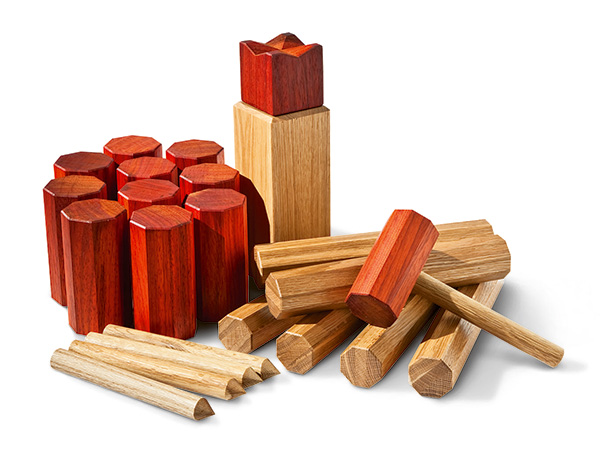
When former Woodworker’s Journal publisher Larry Stoiaken came back to work after a lovely spring weekend talking about playing an entertaining lawn game that was new to him, the conversation turned just a little confusing.
“I played this really fun lawn game this weekend … it’s called Kubb — it was invented by the Vikings,” said Larry.
“Coop?”
“No, Kubb…”
“Coot? Never heard of it…”
“NO, Kubb, k-u-b-b, Kubb.”
“Cub? Huh?”
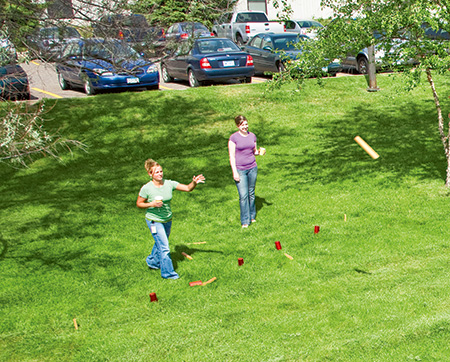
Anyway, once we got the name straightened out, the discussion switched to the game’s heritage and why Larry liked it so much. While Kubb’s origins are obscured by the passing of years — a lot of years — it seems most likely it was invented in Scandinavia more than a thousand years ago. Because the Vikings were such, um … “travelers,” it spread throughout much of northern Europe. Originally the playing pieces were likely firewood. As with many such folk traditions, the rules varied with the region and the period of time. It can be played with anywhere from one to six on a team.
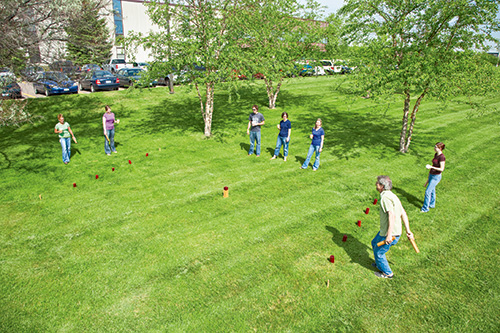
Larry said he liked it because it requires some interesting strategy and a bit of skill, but even if you lack both of those characteristics, you can still enjoy the game fully. We think he favors it because, like horseshoes and bocce, it can be played with one hand left open for a tasty beverage.
Getting Started
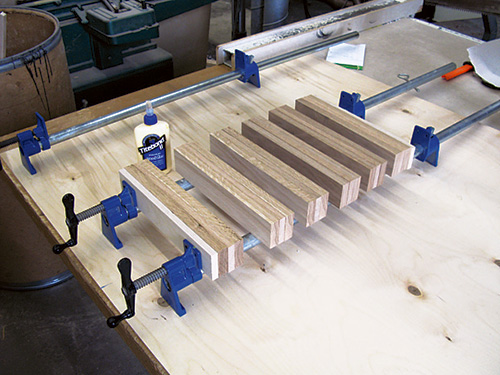
We agreed that this game would make a great summer woodworking project, so we read up on dimensions and shapes and I headed for the shop to get started. Any scrap wood will work, but we felt that heavier, denser wood is a better call for a variety of reasons. We had some padauk and white oak available, both of which seemed to be good choices. You could use any hardwood that you have available locally, and I’m guessing you have enough scrap in your shop right now to build a set or two. We used the white oak for the six casting pins and the rectangular base of the king piece. The four corner stakes and the hammer handle are simple white oak dowels. I used the padauk to make the kubbs, hammer head and crown of the king.
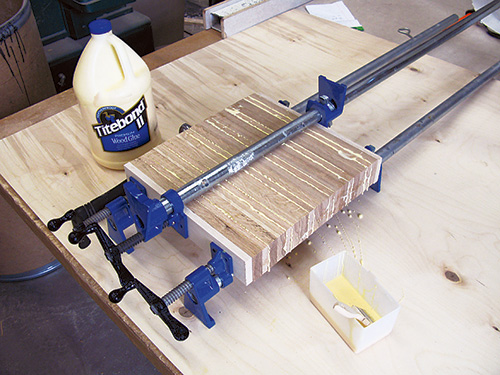
Get your game pieces off to a quick start by gluing up blanks for the casting pins and kubbs. I sped the process along by gluing and clamping my laminations all at once between long clamps.
Making the Ripping Jig
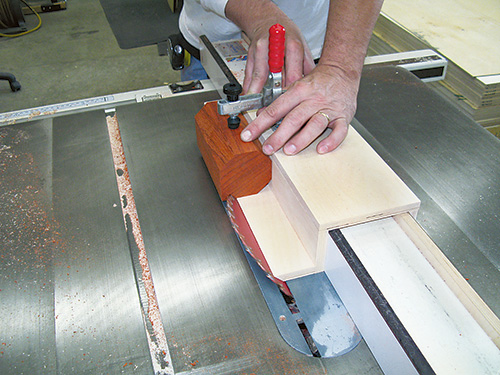
The casting pins, kubbs and hammer head all have octagonal profiles. Since the workpieces are short, I decided that the safest way to bevel-rip them to shape was to build a ripping jig that rides along my saw’s fence. It has a toggle clamp on top that holds the wood securely against the jig base, and a stop at back to prevent workpieces from shifting backward when you push the jig through each cut. Fashion a similar jig to fit your saw’s rip fence, making sure it’s tall enough so the toggle clamp can reach over the larger kubb workpieces.
Notice that the base of the jig supports each workpiece and, when bevel-ripped, also shows you exactly where the blade will contact the wood. To set up your jig the first time, start with a rectangular base that’s wide enough to support the kubb blanks. Tilt your saw blade to 45° and adjust the rip fence so the blade trims the base to 1-15/16″ wide, measured across its top edge.
Bevel-ripping the Octagons
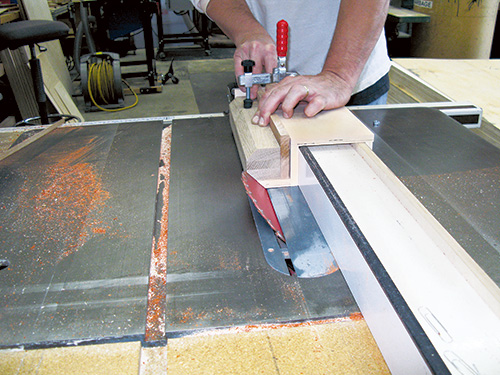
Now that the jig base is trimmed, you can leave the fence in this position for bevel-ripping all of the kubbs and casting pins. Bevel-rip the four corners off of each kubb to form the octagon shapes. Then set a 11/32″-thick spacer board against the jig, and you can proceed to rip the narrower casting pins. Switch to a 1/4″- thick spacer to bevel-rip the hammer head, after first drilling a 1″-diameter, 1-1/4″-deep hole for the hammer handle dowel.
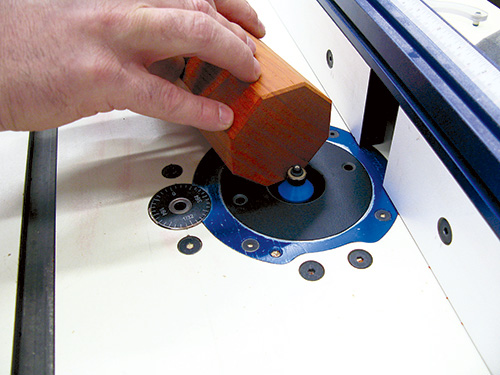
Ease the sharp edges of your kubbs, casting pins and hammer head with a chamfering bit on the router table, set for a light cut.
Making the King
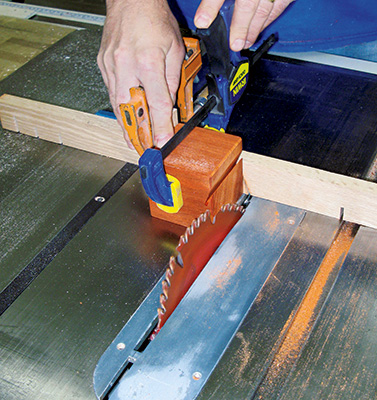
To make the crown for my king piece, I started with a square blank measuring 3″ x 3″. I shaped the crown by raising my saw blade to 1-1/2″ and tilting it to 22.5°. I clamped the blank to a longer scrap fence and a stop block attached to the saw’s miter gauge. Position and clamp the stop block to the scrap fence so the blade will cut into the closest face of the crown blank to a depth of 1-1/2″. I tested this setup on a scrap first to dial in my stop block and blade settings. Four cuts later, I had my crown whipped into shape. Mount the crown on its base however you like, but I suggest using dowels or biscuits to increase your glue surface area.
Wrapping Up
You’ll be able to pound your stakes into the ground more easily if you sharpen their tips. Once you’ve done that, cut the hammer handle to length and glue it into the hammer head.
Give your game pieces a thorough sanding up through the grits. You have many options for finishing outdoor woods, but I settled on General Finishes Outdoor Oil and applied three coats to protect the pieces.
Rules of Engagement
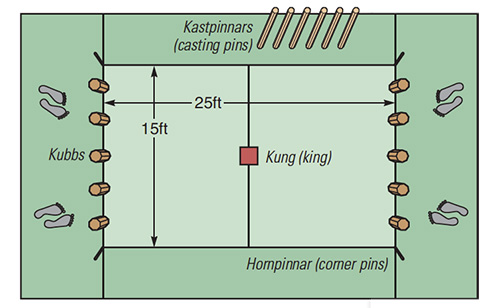
1. Define your playing field by placing the corner pins, king and kubbs. You can have from one to six players on a side. The more players there are on each side, the more time there is to drink beer while playing.
2. Play starts with players standing at their base line and the first team tossing their six casting pins, attempting to topple all five of the other team’s kubbs (underhand tosses only, with vertical, end-over-end rotation). Once that occurs, the king can be attacked and a winner declared.
3. Unless all five kubbs and the king are toppled during the first team’s first turn (an indication that they are not taking the beer drinking aspect of the game seriously enough), the opposing team takes their turn. Play alternates until one team has knocked down all the kubbs and the king. If the king is toppled prematurely, the game is over and the opposing team wins.
4. There are many variations on the game (just Google “Kubb”), featuring increasingly involved and interesting rules. For example, in one variation, when a team has successfully toppled all of the other team’s kubbs but fails to topple the king, the opposing team can bypass attacking the kubbs and go directly for the king, winning the game if they’re successful. When playing this variation, a team with only one casting pin left can choose to forfeit their toss rather than risk toppling the last kubb, which would leave the king vulnerable to their opponent’s attack.





